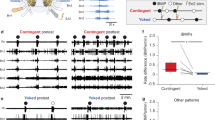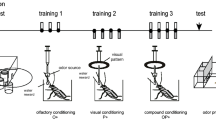Abstract
A long-standing debate in neuroscience is whether classical and operant conditioning are mechanistically similar or distinct. The feeding behavior of Aplysia provides a model system suitable for addressing this question. Here we report that classical and operant conditioning of feeding behavior differentially modify the intrinsic excitability of neuron B51, a critical element for the expression of the feeding response, thus revealing that these two forms of associative learning differ at the cellular level.
This is a preview of subscription content, access via your institution
Access options
Subscribe to this journal
Receive 12 print issues and online access
$209.00 per year
only $17.42 per issue
Buy this article
- Purchase on Springer Link
- Instant access to full article PDF
Prices may be subject to local taxes which are calculated during checkout


Similar content being viewed by others
References
Pavlov, I.P. Conditioned Reflexes (Oxford Univ. Press, Oxford, 1927).
Skinner, B.F. The Behavior of Organisms: An Experimental Analysis (Appleton-Century-Crofts, New York, 1938).
Rescorla, R.A. & Solomon, R.L. Psychol. Rev. 74, 151–182 (1967).
Gormezano, I. & Tait, R.W. Pavlov. J. Biol. Sci. 11, 37–55 (1976).
Raymond, J.L., Baxter, D.A., Buonomano, D.V. & Byrne, J.H. Neural Netw. 5, 789–803 (1992).
Lechner, H.A., Baxter, D.A. & Byrne, J.H. J. Neurosci. 20, 3369–3376 (2000).
Brembs, B., Lorenzetti, F.D., Reyes, F.D., Baxter, D.A. & Byrne, J.H. Science 296, 1706–1709 (2002).
Nargeot, R., Baxter, D.A. & Byrne, J.H. J. Neurosci. 19, 2247–2260 (1999).
Nargeot, R., Baxter, D.A. & Byrne, J.H. J. Neurosci. 19, 2261–2272 (1999).
Mozzachiodi, R., Lechner, H.A., Baxter, D.A. & Byrne, J.H. Learn. Mem. 10, 478–494 (2003).
Plummer, M.R. & Kirk, M.D. J. Neurophysiol. 63, 539–558 (1990).
Morton, D.W. & Chiel, H.J. J. Comp. Physiol. [A] 172, 17–32 (1993).
Byrne, J.H. Physiol. Rev. 67, 329–439 (1987).
Zhang, W. & Linden, D.J. Nat. Rev. Neurosci. 4, 885–900 (2003).
Schultz, W. Neuron 36, 241–263 (2002).
Acknowledgements
We thank H.N. Nguyen for training many of the animals included in this study. This work was supported by the US National Institute of Mental Health (grant MH 58321).
Author information
Authors and Affiliations
Corresponding author
Ethics declarations
Competing interests
The authors declare no competing financial interests.
Supplementary information
Supplementary Fig. 1
Classical conditioning training protocols. (PDF 196 kb)
Supplementary Fig. 2
Classical conditioning did not alter the CS-evoked inhibitory synaptic input to neuron B51. (PDF 192 kb)
Supplementary Fig. 3
Classical conditioning did not alter either the resting membrane potential or the input resistance of neuron B51. (PDF 291 kb)
Rights and permissions
About this article
Cite this article
Lorenzetti, F., Mozzachiodi, R., Baxter, D. et al. Classical and operant conditioning differentially modify the intrinsic properties of an identified neuron. Nat Neurosci 9, 17–19 (2006). https://doi.org/10.1038/nn1593
Received:
Accepted:
Published:
Issue Date:
DOI: https://doi.org/10.1038/nn1593
This article is cited by
-
Situating Human Sexual Conditioning
Archives of Sexual Behavior (2017)
-
Phylogenetic and individual variation in gastropod central pattern generators
Journal of Comparative Physiology A (2015)
-
Neural mechanisms of operant conditioning and learning-induced behavioral plasticity in Aplysia
Cellular and Molecular Life Sciences (2011)
-
Transcriptional regulation of long-term memory in the marine snail Aplysia
Molecular Brain (2008)
-
Changes in neuronal excitability serve as a mechanism of long-term memory for operant conditioning
Nature Neuroscience (2008)



